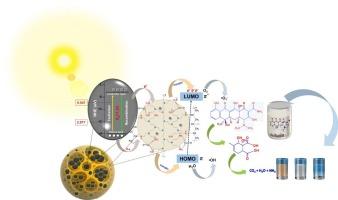功能化聚合物&金属氧化物纳米复合材料的高效抗菌和光催化应用
IF 5.1
3区 工程技术
Q1 CHEMISTRY, APPLIED
引用次数: 0
摘要
功能化聚合物和金属氧化物纳米复合材料以其多功能特性而著称。本文首先在非均相条件下用聚乙烯亚胺(PEI)对聚氯乙烯(PVC)进行改性,制备了功能性聚合物-金属氧化物纳米复合材料。胺化后,Cu (II)离子被吸附在阴离子交换(PPE-4)材料上。然后对所得到的聚合物/金属配合物进行热处理,合成聚合物表面含有氧化铜纳米颗粒的功能纳米复合cuo & PPE-4材料。利用UV-Vis、PL、FTIR、Raman、XRD、SEM-EDX和BET表面分析等手段对合成的功能cuo & PPE-4纳米复合材料进行了表征,对其结构、形貌和理化性质进行了鉴定。对革兰氏阴性的大肠埃希菌(E.coli)和铜绿假单胞菌(P. aeruginosa)以及革兰氏阳性的金黄色葡萄球菌(S. aureus)进行了抑菌活性试验。对大肠杆菌的抑制范围为26±0.5 mm,铜绿假单胞菌的抑制范围为35±0.5 mm,金黄色葡萄球菌的抑制范围为21±0.5 mm,明显超过Cu2+&;PPE-4的抑制范围,这是由于增强了活性氧(ROS)的产生和改善了电荷分离。此外,还对四环素(TC)功能CuO&;PPE-4材料在日光降解下的光催化降解性能进行了评价。紫外可见光谱证实TC在276 nm和358nm处吸光度逐渐下降,表明有有效的光催化作用。该过程遵循准一级动力学,速率常数分别为1.01685 min−1 (5 mg/L TC)、0.90951 min−1 (10 mg/L)和0.48637 min−1 (20 mg/L)。基于高效液相色谱-质谱分析,提出了光催化降解TC的可能反应途径。在150°C下合成的官能化CuO&;PPE-4纳米复合材料比其他材料具有1.53 eV的低带隙,保证了有效的光催化和抗菌活性。此外,实践结果表明,官能化的cuo & PPE-4纳米复合材料可以很好地去除制药废水中的TC。本文章由计算机程序翻译,如有差异,请以英文原文为准。

Functionalized polymer & metal oxide nanocomposite material for efficiency antibacterial and photocatalytic applications
Functionalized polymer&metal oxide nanocomposite materials are distinguished by their multifunctional properties. In this work, for the synthesis of a functional polymer-metal oxide nanocomposite material, polyvinyl chloride (PVC) was first modified with polyethyleneimine (PEI) under heterogeneous conditions. After amination, the Cu (II) ions were adsorbed onto anion-exchange (PPE-4) material. The resulting polymer/metal complex was then thermally treated to synthesize a functional nanocomposite CuO&PPE-4 material containing copper oxide nanoparticles on the polymer surface. Synthesized functional CuO&PPE-4 nanocomposite material was characterized using UV–Vis, PL, FTIR, Raman, XRD, SEM-EDX, and BET surface analysis to identification its structure, morphology, and physico-chemical properties. The antibacterial activity was tested against Escherichia coli (E.coli) and Pseudomonas aeruginosa (P. aeruginosa) for Gram-negative as well as Staphylococcus aureus (S. aureus) for Gram-positive bacteriums. Revealing a 26 ± 0.5 mm inhibition zone for E. coli, 35 ± 0.5 mm for P. aeruginosa and 21 ± 0.5 mm S. aureus which significantly exceeded that of Cu2+&PPE-4 due to enhanced reactive oxygen species (ROS) generation and improved charge separation. Moreover, the photocatalytic degradation of the functional CuO&PPE-4 material of tetracycline (TC) was evaluated under sunlight degradation. UV–Vis spectroscopy confirmed a progressive decline in TC absorbance at 276 nm and 358 nm, indicating effective photocatalysis. The process followed pseudo-first-order kinetics, with rate constants of 1.01685 min−1 (5 mg/L TC), 0.90951 min−1 (10 mg/L), and 0.48637 min−1 (20 mg/L). Possible reaction pathways for the photocatalytic degradation of TC are presented based on HPLC MS analysis. The functionalized CuO&PPE-4 nanocomposite material synthesized at 150 °C exhibited a low band gap of 1.53 eV than other materials, which ensured effective photocatalytic and antibacterial activities. Furthermore, practical results show that the functionalized CuO&PPE-4 nanocomposite material removes TC very effectively from pharmaceutical industry wastewater.
求助全文
通过发布文献求助,成功后即可免费获取论文全文。
去求助
来源期刊

Reactive & Functional Polymers
工程技术-高分子科学
CiteScore
8.90
自引率
5.90%
发文量
259
审稿时长
27 days
期刊介绍:
Reactive & Functional Polymers provides a forum to disseminate original ideas, concepts and developments in the science and technology of polymers with functional groups, which impart specific chemical reactivity or physical, chemical, structural, biological, and pharmacological functionality. The scope covers organic polymers, acting for instance as reagents, catalysts, templates, ion-exchangers, selective sorbents, chelating or antimicrobial agents, drug carriers, sensors, membranes, and hydrogels. This also includes reactive cross-linkable prepolymers and high-performance thermosetting polymers, natural or degradable polymers, conducting polymers, and porous polymers.
Original research articles must contain thorough molecular and material characterization data on synthesis of the above polymers in combination with their applications. Applications include but are not limited to catalysis, water or effluent treatment, separations and recovery, electronics and information storage, energy conversion, encapsulation, or adhesion.
 求助内容:
求助内容: 应助结果提醒方式:
应助结果提醒方式:


